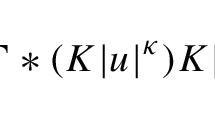Abstract
A simple random walk model has been shown by Gaveauet al. to give rise to the Klein-Gordon equation under analytic continuation. This absolutely most probable path implies that the components of the Dirac wave function have a common phase; the influence of spin on the motion is neglected. There is a nonclassical path of relative maximum likelihood which satisfies the constraint that the probability density coincide with the quantum mechanical definition. In three space dimensions, and in the presence of electromagnetic interaction, the Lagrangian for this optimal, nonclassical path coincides with the Lagrangian of the Dirac particle. The nonrelativistic, or diffusion, limit is shown to be a formal consequence of Einstein's dynamical equilibrium condition; the continuity equation reduces to the same diffusion equation derived from Schrödinger's equation. The relativistic, massless limit, which would describe a neutrino, is comparable (in the sense of analytic continuation) to a nonviscous liquid whose molecules possess internal degrees of freedom.
Similar content being viewed by others
References
R. P. Feynman and A. R. Hibbs,Quantum Mechanics and Path Integrals (McGraw-Hill, New York, 1965), problem 2–6, pp. 34–36.
B. Gaveau, T. Jacobson, M. Kac, and L. S. Schulman,Phys. Rev. Lett. 53, 419 (1984).
M. Kac,Rocky Mountain J. Math. 4, 497 (1974).
L. de Broglie,Non-Linear Wave Mechanics: A Causal Interpretation (Elsevier, Amsterdam, 1960), p. 205.
H. A. Gersch,Int. J. Theor. Phys. 20, 491 (1981); B. H. Lavenda,Prog. Theor. Phys. 75, 243 (1986).
R. Kikuchi,Phys. Rev. 124, 1682 (1961).
R. Kikuchi and P. Gottlieb,Phys. Rev. 124, 1691 (1961).
J. J. Sakurai,Advanced Quantum Mechanics (Addison-Wesley, Reading, Massachusetts, 1967), p. 169.
B. H. Lavenda and C. Cardella,J. Phys. A: Math. Gen. 19, 395 (1986).
B. H. Lavenda,Nonequilibrium Statistical Thermodynamics (Wiley-Interscience, Chichester, 1985), Sections 1.4 and 7.4.
J. D. Jackson,Classical Electrodynamics (Wiley, New York, 1962), p. 671.
E. Nelson,Quantum Fluctuations (Princeton University Press, Princeton, 1985), p. 32. A critical assessment can be found in B. H. Lavenda and E. Santamato,Int. J. Theor. Phys. 23, 585 (1984).
A. Einstein,Investigations on the theory of Brownian movement (Dover, New York, 1956), p. 73ff.
J. Frenkel,Kinetic theory of Liquids (Ocford, London, 1946), Chapter U, Section 7.
S. R. de Groot and P. Mazur,Non-equilibrium Thermodynamics (North-Holland, Amsterdam, 1962), p. 305.
L. D. Landau and E. M. Lifshitz,Fluid Mechanics (Pergamon, Oxford, 1959), p. 247.
Author information
Authors and Affiliations
Additional information
Dedicated to Professor Alfonso Maria Liquori on the occasion of his 60th birthday.
Rights and permissions
About this article
Cite this article
Lavenda, B.H. Classical variational derivation and physical interpretation of Dirac's equation. Found Phys 17, 221–237 (1987). https://doi.org/10.1007/BF00733091
Received:
Revised:
Issue Date:
DOI: https://doi.org/10.1007/BF00733091




